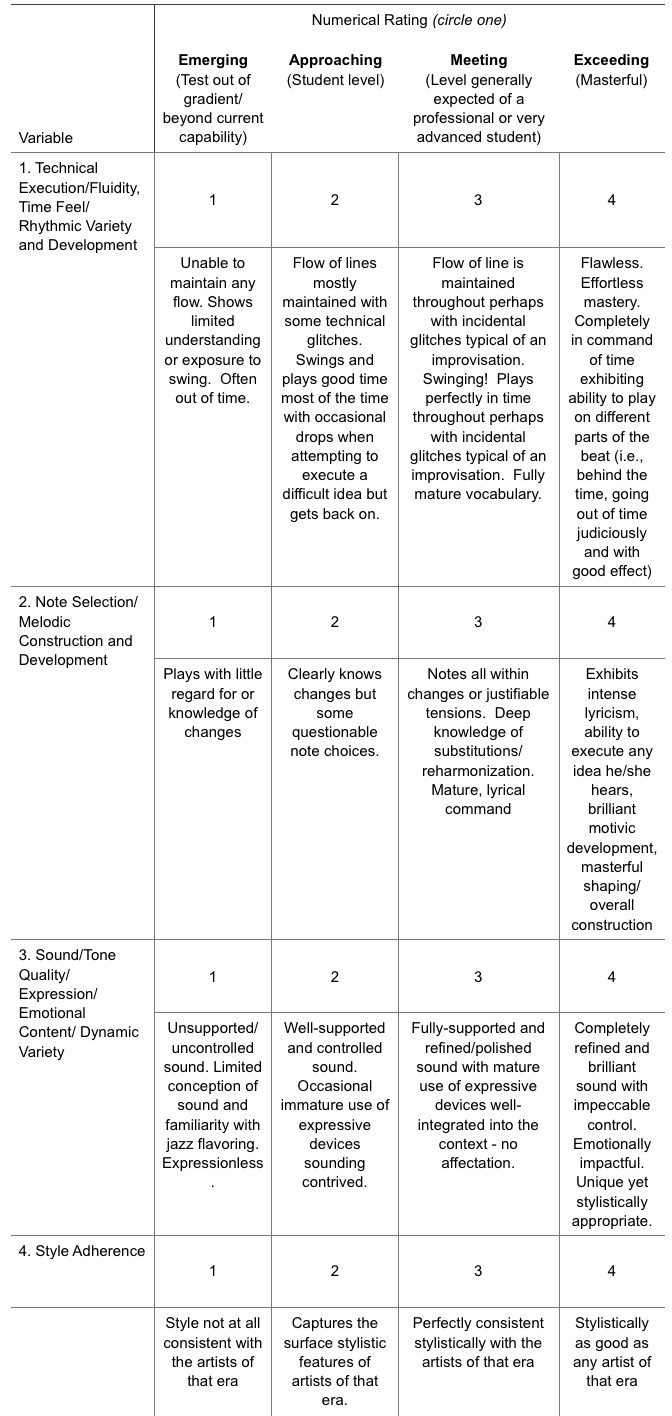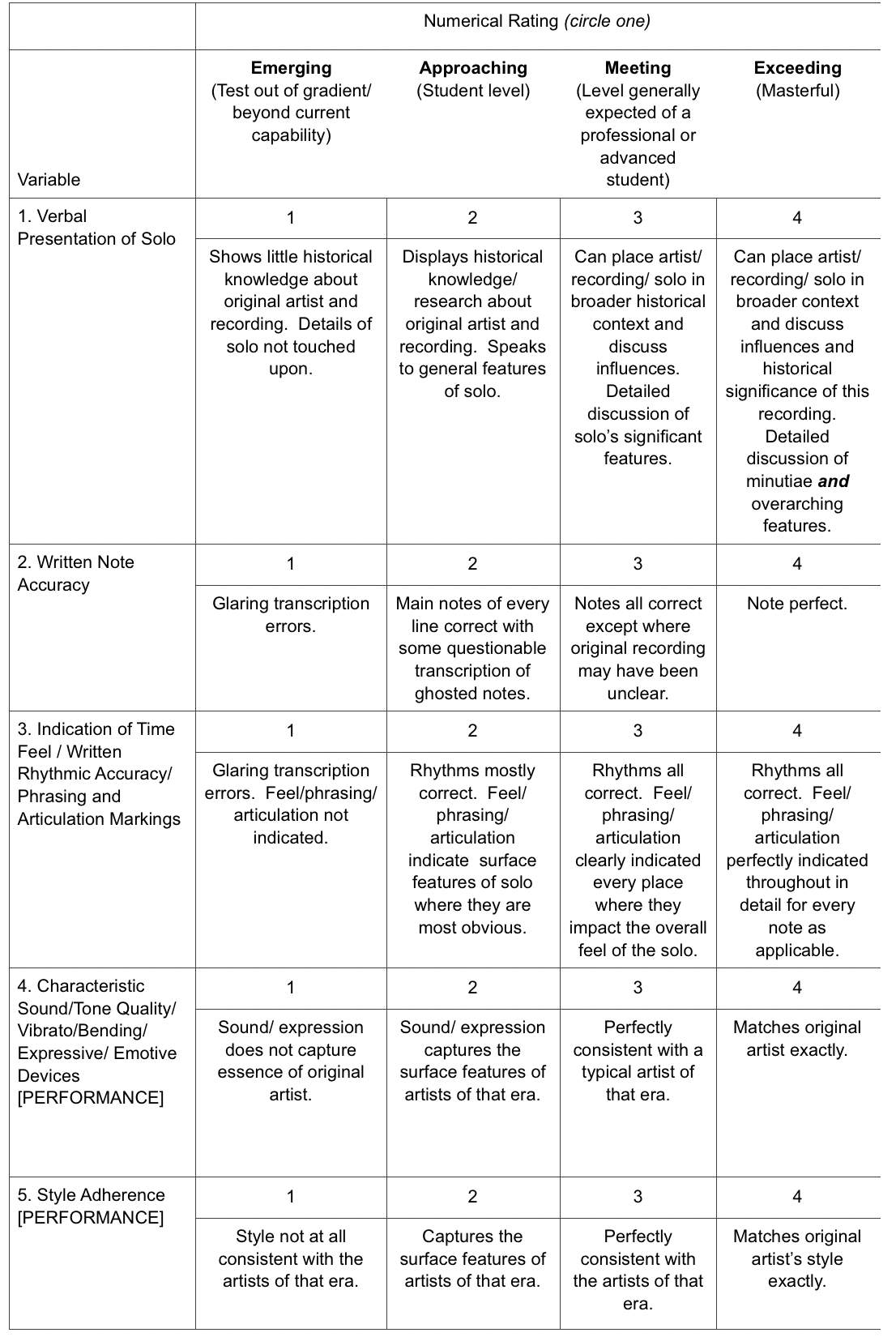
JAZZ IMPROVISATION ACROSS TRADITIONAL AND MODERN STYLES: ASSESSMENTS IN A SIX-WEEK UNIT WITHIN A UNIVERSITY-LEVEL JAZZ IMPROVISATION COURSE
PART 3 OF 4: SUMMATIVE ASSESSMENT — IMPROVISATION, TRANSCRIPTION
Ray P. Zepeda
Last month, we entered into a discussion about emulation, both of our fathers and of our jazz mentors, whether consciously or unwittingly. For this third of four installments, I would like to do a deeper dive into specific methods of study of our jazz mentors, namely, the practice of solo transcription and what I call “style” improvisation, and how these might actually enable a developing artist’s independence. Freed from the tyranny of the written page, the performer operates on a tightrope without a net, a Faustian bargain for freedom of artistic expression.
Imagine another situation differing only in matter of degree. You are a twenty-something young man in 1776 Colonial America yearning for freedom from tyranny. What price would you pay to secure it? Would you sign your life away on a piece of paper for all to see all but guaranteeing your being tried and executed for treason? (How many men of any age would do that today?) In August of that year, 56 intrepid men from throughout the Colonies did just that with full knowledge of the potential consequences. While the gamble paid off, forming the basis for the greatest nation in human history, it was one of the greatest leaps of faith ever taken.
The leap of faith we as jazz educators ask of our developing students is not nearly so great, something they should be reflecting on especially during today’s practice session. Moreover, we encourage using “templates” from the masters, transcribing their solos and emulating their performances in every detail. Our Founding Fathers certainly did have some “templates” to go on such as British Common Law, various Parliamentary systems, Judeo-Christian values, and the basic tenets of Western Civilization, but many of the principles upon which our nation was founded were sui generis. While jazz as an artform was created this way, the development of a jazz improviser is rarely ever so. While failure was not an option for our Founders, I encourage you to fail and to do so over and over again.
Wishing you and yours a physically safe and sane Fourth of July!
Rubric
Unit Final Test Performance
As I have done on the Formative Assessments throughout this Unit, I will score each chorus of each soloist’s improvisation across four dimensions on a scale from 1 to 4. Each soloist will get three choruses of each of the following: (1) a Traditional style (2) a Modern style, both of the soloist’s choosing, over a tune of the soloist’s choosing. You may use a rhythm section from the class or, for the more technologically savvy amongst you, the original recording with the soloist muted. Explain why you chose these two styles.
Traditional styles: Ragtime, Dixieland/Trad. Jazz, Early to Late Swing, Early R&B, etc.
Modern styles: Bebop, Hard Bop, West Coast/Cool, Post Bop, Modal Jazz, Progressive Jazz/Third Stream, Fusion, Contemporary/Smooth Jazz, etc.
The highest chorus score of each solo will be taken for each of the evaluations — (1) and (2). Each soloist will therefore play six total choruses. The scores in each of the four dimensions will be averaged to yield a composite score. A composite letter grade translation for reference, roughly speaking, might be:
A: 3 and higher
B: 2
C: 1
Table 1
Improvisation Evaluation Scale: Traditional / Modern Jazz [adapted in part from Smith (2009)]

Comments:
Throughout this 6-week Unit, you have also been working on transcribing by hand one chorus of your choosing from two solos by an artist on your instrument, one from a traditional style and one from a modern style, and practicing to perform it as much like the original artist as possible. I will collect your handwritten transcriptions for grading and will give each student one opportunity to perform each of their two solo transcriptions. Performances are to be a cappella or with the original recording at low volume Your transcriptions and performances will be assessed according to Table 2 below. Explain why you chose these two solos and have your handwritten solo on the overhead for the class to see while you perform it. You will preface your performance with a brief presentation which will include a discussion of your artist and their style highlighting historical details about the original recording and technical details in the solo transcription.
Table 2
Transcription — Notation and Performance Evaluation Scale: Traditional / Modern Jazz [adapted in part from Smith (2009)]

Comments:
Scale Detail for Assessment:
3 above: Exhibits or exemplifies the parameter or characteristic nearly perfectly throughout
2: Exhibits the parameter or characteristic moderately or mostly throughout
1: Does not exhibit the parameter or characteristic to any measurable degree
The scores in each of the five dimensions will be averaged to yield a composite score. A composite letter grade translation for reference, roughly speaking, might be:
A: 3 and higher
B: 2
C: 1
References
Smith, D. (2009). Development and Validation of a Rating Scale for Wind Jazz Improvisation Performance. Journal of Research in Music Education, 57, 217-235.